Welcome To The Jungle by Joe Cermele
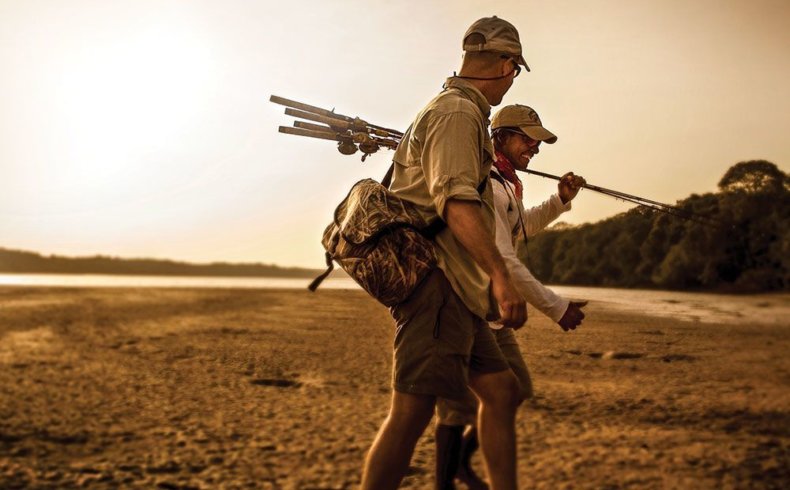
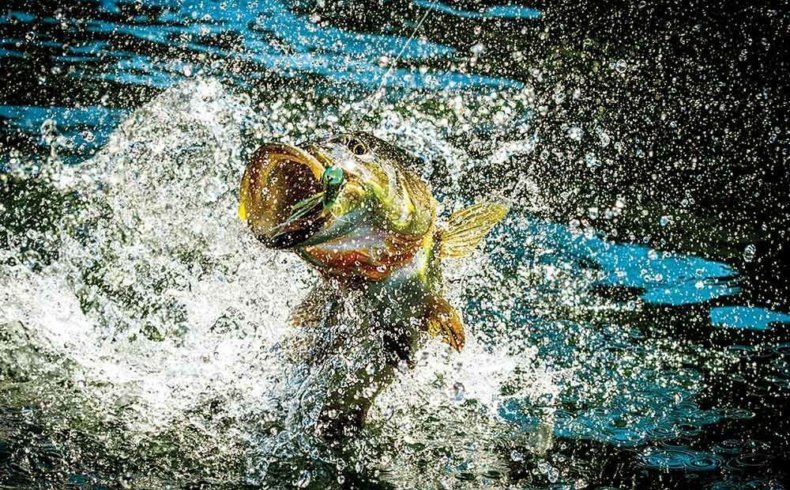

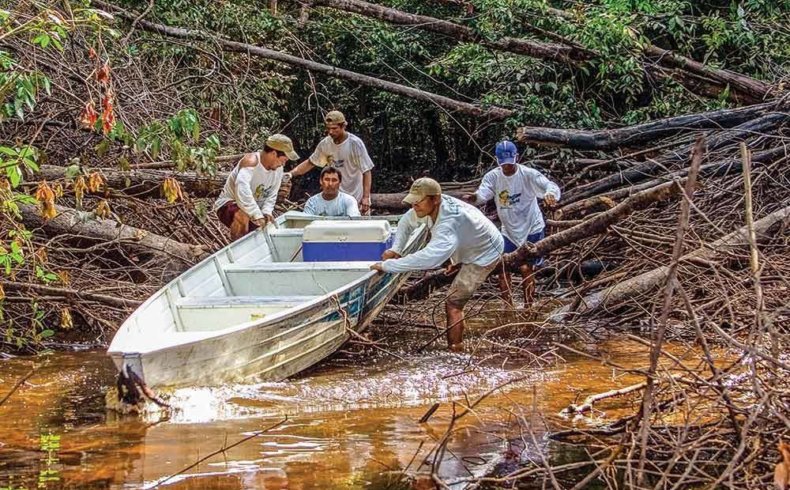
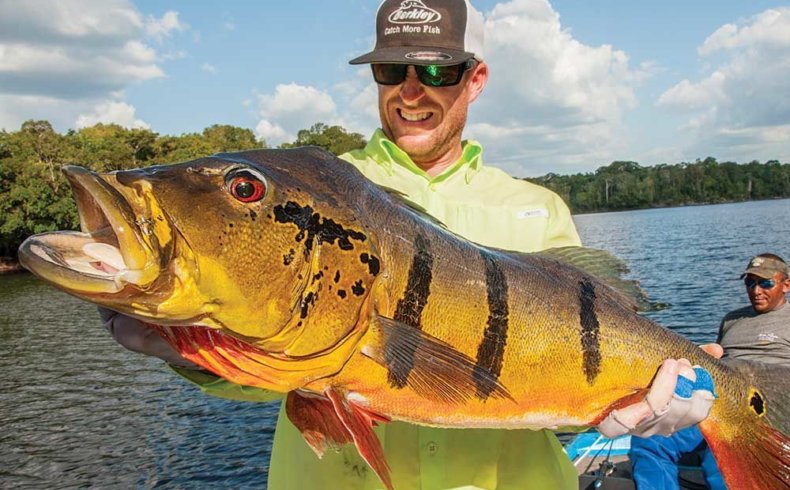

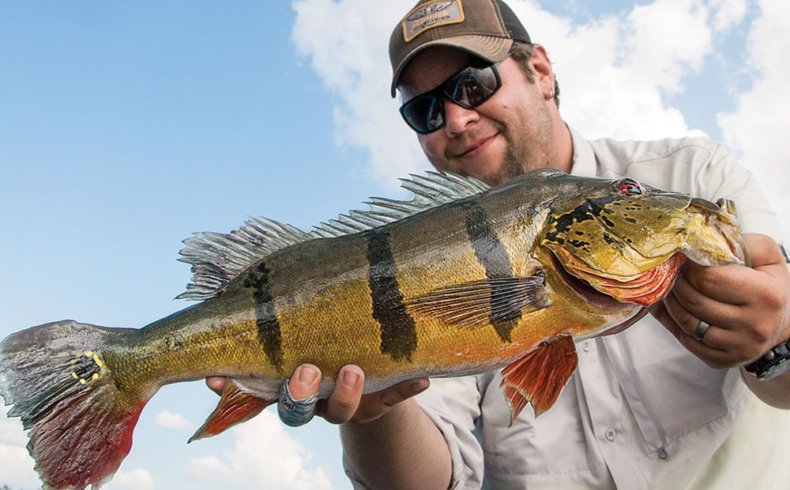
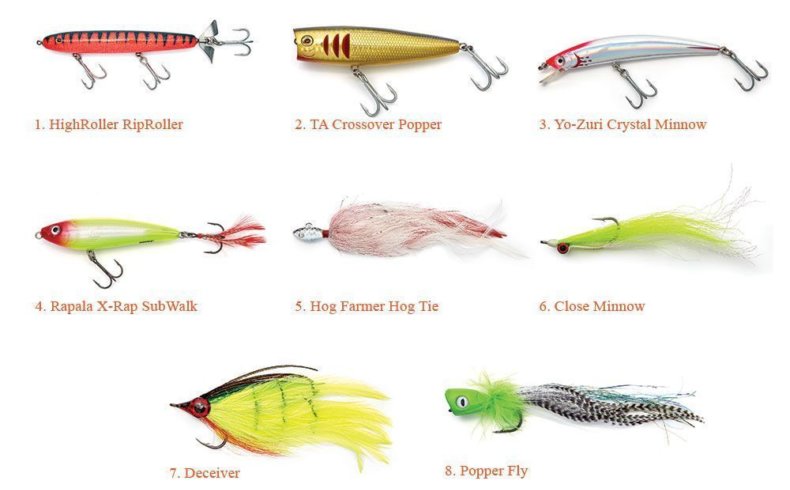





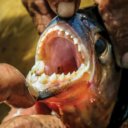


My love affair with peacock bass began with a shopping cart back in 2011.
Overhead, another 747 climbed out of Miami International with a brain-rattling roar. Behind me, brakes squealed on the Dolphin Expressway as traffic chipped away at the morning rush hour. But I ignored it all as my Clouser Minnow wiggled past that rusty cart, poking through the surface of the canal. In a flash of fiery green, the fly vanished, and while the peacock bass that delivered the blow only weighed about 2 pounds, it nearly put me in my backing. I was so taken by the power of that little Florida implant that I knew one day I had to chase these fish in their native waters—the Amazon.
The opportunity took four years to present itself. The call came from my good friend Kevin Jarnagin, who was working with Anglers Inn International, arguably Brazil’s premier peacock outfitter. The plan: Take a mother ship up the Rio Negro from the city of Manaus to the lodge, situated just south of the equator, and watch 20-pounders explode on topwater lures. The reality: Fishing in the Amazon was very different from my expectations. Jarnagin and I had six days to scratch giant peacocks off our bucket lists, and what we learned during that time will not only prepare you for fishing in this harsh environment but also give you an edge in hooking a once-in-a-lifetime goliath jungle bass.
Comfortable and Quenched
Hot Topic
Think of the most scorching day you’ve ever experienced. Now, multiply that by 10. That’s what it’s like to fish the equator. Yet, when the sun went down during our first evening aboard the Amazon Santana, the breeze was surprisingly refreshing—as were the ice-cold Brahma beers our group started to knock back. Jarnagin and I had maybe five apiece over the course of a few hours—by no means a drunkfest. Our mistake, though, was not drinking any water. The next morning, despite being amped to start casting at peacocks, the sun and heat zapped us after just an hour on the bass boat. I was so weak and dizzy I could barely focus on fishing, and it took about three hours and a case of water to get Jarnagin and me back to normal. I think I had four adult beverages the entire rest of the trip.
Nothing is more critical than hydration when fishing the Amazon, we’d discovered, and when you’re working big lures all day, water often isn’t enough. Mini Pedialyte and Gatorade packets are a must, as is a generous slathering of SPF 100 throughout the day. And if you’re one of those people who think Buffs, sun gloves, and sun shirts are hokey, you’ll quickly change your tune.
Ground Game
In the Amazon, it’s not uncommon to beach the boat and hop out for foot missions. We did this daily, since the white sand bottom made for muck-free wading and for easy hikes to cut-off lagoons. Just don’t ever go barefoot, no matter how inviting that bottom may look. Remember: Every plant in the Amazon wants to hurt you, as our guide found out on our third day, after he stepped on a sunken piece of spike-covered palm bark, requiring impromptu foot surgery. Not only that, freshwater stingrays with poison-tipped tails are hiding everywhere. You’re nowhere near a clinic, so don’t step on one. Bring flats booties or quick-drying water sneakers.
On The Hunt
Heavy Lifting
From the beginning of the trip, Jarnagin and I kept reminding ourselves that some of the heaviest peacock bass on record have fallen in the Rio Negro. What we had to remember, however, is that catching a fish at the top of its weight class is a challenge wherever you go.
On day one, after recovering from our beer-fueled dehydration, we found that hooking a high-end peacock was similar to a muskie quest: You’re going to put in a lot of hunt time and make tons of casts, but even with a week on the water, there’s just no guarantee that a big girl is going to play. After nearly six hours of fishing that first day, Jarnagin’s topwater finally got smashed. Our icebreaker fish weighed only 8 pounds, but given the amount of work we put in for it, we were ecstatic.
Chopping Block
Most anglers who visit the Amazon dream of seeing a huge peacock smack a surface lure, and a HighRoller RipRoller—a lookalike of a discontinued prop bait called the Wood Chopper—helps satisfy this dream more often than any other topwater. But “chopping” takes commitment. To work the lure effectively, make a long cast, then stroke downward forcefully. The louder and more aggressively it zips, the more likely you are to move a monster. And should a beast swing and miss, whatever you do, don’t stop the retrieve. Jarnagin learned this the hard way on our third day, after a 20-pounder took a shot and refused to come back after a brief pause.
The most dedicated topwater junkies will chop all day, every day. But no matter how much you plan to use this lure, pack a roll of Flexx-Rap finger wrap. It was indispensable for fighting rod rash and blistering.
Big Easy
Statistically, more giant peacocks fall to a simple bucktail jig slow-trolled behind a boat than to any other lure. If this is more appealing than chopping wood, all you have to do is crack open a cold Guaraná Antarctica—Brazil’s most popular soda—and let your guide work the trolling motor until a jumbo latches on. Jarnagin and I never dabbled with the method, but the biggest fish caught by our group, a 22-pounder, ate a trolled jig.
Let It Fly
Since both the white sand flats and miles of structure-rich shorelines are a fly caster’s dream, I spent a good chunk of time throwing fur and feathers. My experience was that you can put up huge numbers of peacocks by stripping bugs, but hooking a giant on the fly requires focusing exclusively on the task. On our fifth day, I had a legitimate shot at a 15-pounder, but it spooked as soon as my fly touched down. I worked everything from foot-long muskie streamers to 5-inch saltwater Deceivers down miles of bank, and in several spots where our guide was confident we’d find a goliath. My takeaway: It’s hard to replicate with a fly the vibration of lures that trophies eat, and even harder to retrieve flies as aggressively as you need to for a big reaction strike. Despite my best efforts, my biggest peacock on the fly weighed 5 pounds and fell to a simple Clouser.
Fighting Words
If you want a pig on the surface, you’re smart to stick to the mission all day. But if you’d rather just keep the rods bent, switch to smaller jigs, hard baits, or flies, and hit the endless number of deadfalls and pockets. Our experience was that big fish were loners or in pairs; in spots where peacocks were piled in, they typically topped out at 5 or 6 pounds. Though fish of that size may sound manageable compared with a 20- pounder, make no mistake—a 5-pound peacock is going to take you for a ride. Most of the time, that ride leads to the closest hard structure, where the fish will attempt to snap you, so goal No. 1 is side-pressuring a peacock away from the bank.
Pest Control
The Amazon is caiman central, but what you really need to worry about are the pink river dolphins. They would circle our boat daily and would pounce as soon as we released a catch. To give our peacocks a chance, we gently slipped them back into the water, so they could bolt for cover before Flipper attacked.
Jungle Tackle
Carry a Big Stick
In Florida, an 8-pound peacock is a giant, which makes targeting them with light tackle exceptional. But in the Amazon, you never know when a 20-pounder will strike, so err on the side of heavier tackle, which you’ll also need to wing and work the large lures these fish smash. We threw heavy-action 7-foot baitcasting sticks matched with low-profile Abu Garcia Revo Beast reels; their carbon drags and cranking power could handle every lure in the arsenal and provided the muscle to keep these hard-brawling fish from running into cover.
Wrong Terminal
Knowing that popping into the tackle shop wouldn’t be an option, I flew to Brazil with a dozen spools of fluorocarbon and a ton of clips and barrel swivels. And I didn’t use any of it while fishing with conventional gear. We found out during a chat with lodge owner Billy Chapman Jr. that terminal tackle does more harm than good. Amazon peacocks are so aggressive that line spooking is no concern; clips and snaps are just more things that can fail during a fight. All of our reels were spooled with 65-pound braid, and we tied our baits directly to it with trusty Palomar knots. Doing so didn’t seem to lower our strike numbers, and we never broke off a fish.
Frequent Flyers
Whether you plan to make an Amazon visit a fly-only quest or intend to throw the whip stick intermittently, pack a 9-weight rod. It will be just a hair heavy for 3- to 5-pound fish, be just right for 10- to 15-pounders, and make anything bigger sporty but manageable. You’ll definitely want a full-floating line for topwater flies. And you can use a floater exclusively for most subsurface presentations, but I also brought an intermediate sink-tip for deeper water and to get bulky flies under fast.
Amazon Ammo
Tough customers
Amazon peacocks will thrash countless lures and flies. These eight favorites not only landed the fish reliably but also survived days of abuse on the water.
1. HighRoller RipRoller
This riff on the original Wood Chopper calls more giant peacocks to the surface than any other topwater. The downside: You can dislocate your shoulder chucking one all day.
2. Tactical Anglers Crossover Popper
The productive popper kept us in the surface game without subjecting us to the pain of chopping a RipRoller.
3. Yo-Zuri Crystal Minnow
If peacocks aren’t moving on the surface, a big Crystal Minnow will move them below.
4. Rapala X-Rap SubWalk
This subsurface walking bait put up big numbers and became our go-to for schooled-up peacocks.
5. Hog Farmer Hog Tie
This extra-long bucktail and feather jig has a nice big profile, and buys you time, since it takes a while for nipping piranhas to render its tail too short to fish.
6. Clouser Minnow
Hands down, this was my most effective fly. Bring a lot of them, because they’ll get chewed up fast; and heavy saltwater hooks are a must.
7. Deceiver
Saltwater-grade Deceivers in bright colors are Amazon staples. For me, a double- handed retrieve scored the most strikes.
8. Popper Fly
Poppers sized for smallmouths produced tons of blowups, but bring muskie-size poppers if you’re after a trophy.
The Verdict
Ultimately, Jarnagin and I never managed to break the 20-pound mark, though certainly not for lack of trying. In the end, our personal-best peacocks weighed 17 and 12 pounds, respectively. So, was the trip worth it? Hell yes. An Amazon adventure is a once-in-a-lifetime trip—but once in a lifetime just isn’t enough for me. I daydream just as often now about an Amazon trip as I did before I left, imagining a RipRoller I’ve fired into some dark lagoon landing in front of a giant peacock, more than eager to strike.